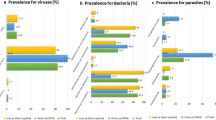Abstract
The detection of Plasmodium spp. by the molecular analysis of human feces was reported to be comparable to detection in the blood. We believe that for epidemiological studies using molecular tools, it would be simpler to use feces, which are easier to obtain and require no training for their collection. Our aim was to evaluate the usefulness of feces for the detection of these pathogens towards developing a new tool for their surveillance. Between 2008 and 2010, 451 human fecal samples were collected in two Senegalese villages in which malaria and rickettsioses are endemic. Rickettsia and Plasmodium DNA were detected using quantitative PCR targeting Rickettsia of the spotted fever group, R. felis and Plasmodium spp. Two different sequences were systematically targeted for each pathogen. Twenty of the 451 fecal samples (4.4 %) were positive for Rickettsia spp., including 8 for R. felis. Inhabitants of Dielmo were more affected (18/230, 7.8 %; p = 0.0008) compared to those of Ndiop (2/221, 0.9 %). Children under 15 years of age were more often positive (19/285, 6.7 %) than were older children (1/166, 0.6 %; p = 0.005, odds ratio = 11.79). Only one sample was positive for Plasmodium spp. This prevalence is similar to that found in the blood of the Senegalese population reported previously. This preliminary report provides a proof of concept for the use of feces for detecting human pathogens, including microorganisms that do not cause gastroenteritis, in epidemiological studies.
Similar content being viewed by others
References
Duval L, Fourment M, Nerrienet E, et al. African apes as reservoirs of Plasmodium falciparum and the origin and diversification of the Laverania subgenus. Proc Natl Acad Sci USA. 2010;107:10561–6.
Duval L, Ariey F. Ape Plasmodium parasites as a source of human outbreaks. Clin Microbiol Infect. 2012;18:528–32.
El Kechine A, Henry M, Raoult D, Drancourt M. Detection of Mycobacterium tuberculosis complex organisms in the stools of patients with pulmonary tuberculosis. Microbiology. 2009;155:2384–9.
Jirku M, Pomajbikova K, Petrzelkova KJ, Huzova Z, Modry D, Lukes J. Detection of Plasmodium spp. in human feces. Emerg Infect Dis. 2012;18:634–6.
Liu W, Li Y, Learn GH, et al. Origin of the human malaria parasite Plasmodium falciparum in gorillas. Nature. 2010;467:420–5.
Peeters M, Delaporte E. Simian retroviruses in African apes. Clin Microbiol Infect. 2012;18:514–20.
Keita AK, Socolovschi C, Ahuka-Mundeke S, et al. Molecular evidence for the presence of Rickettsia felis in the feces of wild-living African apes. PLoS ONE. 2013;8:e54679.
Mediannikov O, Socolovschi C, Edouard S, et al. Common epidemiology of Rickettsia felis infection and malaria, Africa. Emerg Infect Dis. 2013;19:1775–83.
Mediannikov O, Fenollar F, Bassene H, et al. Description of “yaaf”, the vesicular fever caused by acute Rickettsia felis infection in Senegal. J Infect. 2013;66:536–40.
Socolovschi C, Mediannikov O, Sokhna C, et al. Rickettsia felis-associated uneruptive fever, Senegal. Emerg Infect Dis. 2010;16:1140–2.
Sokhna C, Mediannikov O, Fenollar F, et al. Point-of-care laboratory of pathogen diagnosis in rural Senegal. PLoS Negl Trop Dis. 2013;7:e1999.
Richards AL, Jiang J, Omulo S, et al. Human infection with Rickettsia felis, Kenya. Emerg Infect Dis. 2010;16:1081–6.
Trape JF, Rogier C, Konate L, et al. The Dielmo project: a longitudinal study of natural malaria infection and the mechanisms of protective immunity in a community living in a holoendemic area of Senegal. Am J Trop Med Hyg. 1994;51:123–37.
Trape JF, Tall A, Sokhna C, et al. The rise and fall of malaria in a West African rural community, Dielmo, Senegal, from 1990 to 2012: a 22 year longitudinal study. Lancet Infect Dis. 2014;14:476–88.
Keita AK, Bassene H, Tall A, et al. Tropheryma whipplei: a common bacterium in rural Senegal. PLoS Negl Trop Dis. 2011;5:e1403.
Fenollar F, Mediannikov O, Socolovschi C, et al. Tropheryma whipplei bacteremia during fever in rural West Africa. Clin Infect Dis. 2010;51:515–21.
Socolovschi C, Pages F, Ndiath MO, Ratmanov P, Raoult D. Rickettsia species in african anopheles mosquitoes. PLoS ONE. 2012;7:e48254.
Maina AN, Knobel DL, Jiang J, et al. Rickettsia felis infection in febrile patients, western Kenya, 2007–2010. Emerg Infect Dis. 2012;18:328–31.
Fenollar F, Trape JF, Bassene H, Sokhna C, Raoult D. Tropheryma whipplei in fecal samples from children, Senegal. Emerg Infect Dis. 2009;15:922–4.
Keita AK, Bassene H, Tall A, et al. Tropheryma whipplei: a common bacterium in rural Senegal. PLoS Negl Trop Dis. 2011;5:e1403.
Roucher C, Rogier C, Sokhna C, Tall A, Trape JF. A 20-year longitudinal study of Plasmodium ovale and Plasmodium malariae prevalence and morbidity in a West African population. PLoS ONE. 2014;9:e87169.
Li Y, Ndjango JB, Learn GH, et al. Eastern chimpanzees, but not bonobos, represent a simian immunodeficiency virus reservoir. J Virol. 2012;86:10776–91.
Konstantinov SR, Kuipers EJ, Peppelenbosch MP. Functional genomic analyses of the gut microbiota for CRC screening. Nat Rev Gastroenterol Hepatol. 2013;10:741–5.
Acknowledgments
We would like to thank the entire population of the villages of Dielmo and Ndiop for their contributions to this study. We thank the Agence National de Recherche grant 2010 (MALEMAF) and the Institut Hospitalo-Universitaire Méditerranée Infection for their financial support.
Conflict of interest
The authors have declared that no competing interests exist.
Author information
Authors and Affiliations
Corresponding author
Rights and permissions
About this article
Cite this article
Keita, A.K., Fenollar, F., Socolovschi, C. et al. The detection of vector-borne-disease-related DNA in human stool paves the way to large epidemiological studies. Eur J Epidemiol 30, 1021–1026 (2015). https://doi.org/10.1007/s10654-015-0022-9
Received:
Accepted:
Published:
Issue Date:
DOI: https://doi.org/10.1007/s10654-015-0022-9




